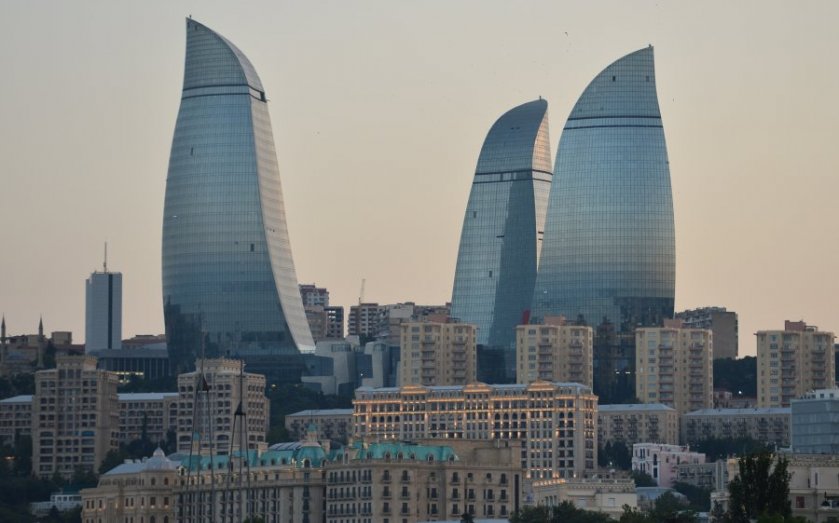Baku is the capital of the Republic of Azerbaijan. It is a large scientific, cultural and industrial center. Ancient foundations, a large area and population all make Baku one of the oldest and largest cities in the East.
People have lived and founded their settlements in Baku city and the Absheron peninsula since ancient times. This was motivated by continuous migrations from north to south and from west to east due to the physical and geographical conditions, a favorable location in the center of trade routes that crossed Silk Road, climatic conditions, production of petroleum fuel in ancient times and the availability of large power resources.
Baku was first mentioned in the Book of the Dead by the Egyptian Pharaoh Minesan in 3,500 BC. The ancient age of Baku is also evidenced by stone carvings dating back to 12,000 years ago and archeological excavations. Another important piece of evidence is a stone carving by August Guy Octavio, who reflected the stationing of a military camp under the rule of the Roman emperors Pompey and Lucius near Baku (40 km to the south) for the purposes
of seizing the southern Caucasus in the 1st century BC. This means that Baku is nearly 5,500 years old.
Baku was one of the main cities in the Shirvanshakhs State in the 12th century, in the Sefevids State in the 14th century, in the Ottoman Empire in the 16th century, and became the capital of the Baku khanate in the 17th century.
Baku is situated on the shore of the Caspian Sea in the south of the Absheron peninsula. It covers an area
of 2,200 square km and has a population of 2 million. Nearly 500,000 refugees from Armenia as well as IDPs from the occupied territories, currently reside in Baku.
Baku has 11 administrative districts and 5 settlements.

HISTORICAL AND CULTURAL MONUMENTS OF BAKU CITY
The ancient city of Baku has numerous historical and architectural monuments dating to various historical epochs.
The Old City of Icheri Sheher occupies 22 hectares in the center of Baku. It hosts over 50 historical and architectural monuments from various eras. The Palace of Shirvanshakhs, the Maiden Tower and Synyg Gala (The Broken Tower) are among the monuments which survived till present day.
The Palace of Shirvanshakhs is one of the pearls of Azerbaijani architecture. It was built in the beginning of the 15th century. It includes a historical complex, the palace, a divankhana, the Shirvanshah’s room, a palace mosque with minarets, bath house, a room of Seyid Yahya Bakuvi, and the Western divankhana monuments, which were built during a later stage. The complex construction began in 1441, while the Western divankhana was completed by architect Amirshah in 1558.
Azerbaijan’s unique architectural monument – the Maiden Tower – is located in the south-western part of the Icheri Sheher. The tower was built in two stages. Its bottom part with a height of 13.7 meters is dated by most experts to the 7th -6th centuries BCE. The Maiden Tower has a total height of 29.7 meters, with a diameter of 16.5 meters. The wall thickness in the bottom part is 5 meters, reducing to 4 meters at the top. The tower consists of 8 tiers and has a 21 meter deep water well.
Another interesting sight in Baku is the Ateshgah temple, situated in south-western part of the Surakhani settlement in the Absheron peninsula, 30 km away from Baku. Ateshgah is a fire temple, built in the XVII-XVIII centuries. The temple’s central stone shrine is located on a natural gas pocket. The present structure was built approximately in 1713 AD, and the building of the central stone shrine was funded by merchant Kanchanagaran in 1810.
One of the most ancient and exciting monuments of Baku is Gobustan, famous around the world for its rock carvings. It has numerous rock carvings, camps, dwelling places, tomb monuments and other sights of the stone period. Gobustan is located in the Boyukdash, Kichikdash, Yindirdag, Sondardag and Shixgaya mountains. The monuments dating from the mesolite to middle ages, can be found in the territory of Boyukdash.
Besides, there are two ancient towers in the Mardakan settlement of Baku. The one with a quadrangular form was built in the 12th century by Akhsitan, the son of Shirvanshah Mechehrin.
This tower was erected on occasion of Akhsitan’s victory over his enemies. The tower has a height of 22 meters. The wall thickness in the bottom part is 2.60 meters, reducing to 1.60 meters at the top. The insides of the tower are divided into five tiers. The second tower has a rounded shape and is known as Shih Tower among the local
population. This tower has a height of 12.5 meters. It’s inner part consists of 3 circles. The inscription on the tower wall reads that it was built by the architect Abdulmejid Masud in 1232.
 Oval Useful news from Azerbaijan and Caucasus
Oval Useful news from Azerbaijan and Caucasus


